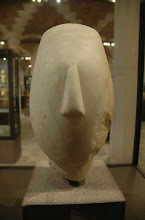 (image: one from the series by Yang Shao Bins’ “Untitled" but not the one in the Half Life show, which I do not have permission to show)
(image: one from the series by Yang Shao Bins’ “Untitled" but not the one in the Half Life show, which I do not have permission to show)
7/11/08 exhibition, Half Life of a Dream
Jeff Kelley, Guest Curator, Writer, and Contemporary Chinese Art Historian
The exhibition carries an underlying and repetitive history of the psychological landscape in post-Maoist China. Marxist and totalitarian, socialist-realism was forcibly taught in Chinese art schools during the rein of Mao. Today the tradition of realism is still taught in the classical sense, but many choose to abstract within but mostly outside of China.
Bullshit theorists might argue that these abstractions represent a rebellion of tradition, structure, and oppression. However, although these contemporary works lack the political propaganda, they still leave deep scares of social oppression and fear induced prowess. A prowess that is aesthetically undeniable, but somehow overcompensates for a lack of emotional freedom where contemporary natives still feel the reverberations of a nation lacking individuality and political autonomy.
This disillusionment of a suppressed nation and society is a preeminent theme from which derives such raw and powerful works, many of which are a hybrid of two-dimensional works incapable of being contained as seen in Li Songsongs’ “Someday My Prince Will Come.” This large scale impasto oil painting is over an inch in thickness, and a diptych of different canvas depths, where it becomes inevitably three dimensional.
One of the most poignant and powerful pieces is a large scale painting by superstar artist Yang Shao Bins’ “Untitled.” The work depicts infants, self portraits of the artist, which although abstracted still evoke violence; a tearing of the self to pieces, of phantoms and apparitions, innocence and nightmares and ultimately, beauty.
The show is a reminder of what was, and still is today. A Half-Life, or state of semi-consciousness; a world between accepting a depressive fate and dreaming of a different and perhaps an idealized society.
Although eerie and odd, there are pieces that amuse, that amaze, and that inspire. However, they all seem to have an undeniable sense of sadness to them, of muted insecurity and fear. –Eve





No comments:
Post a Comment